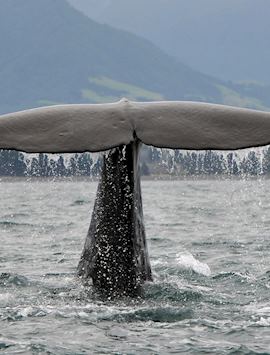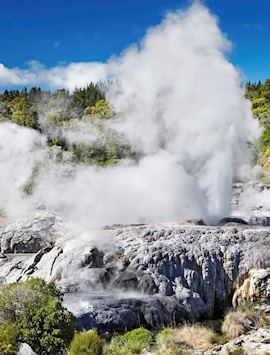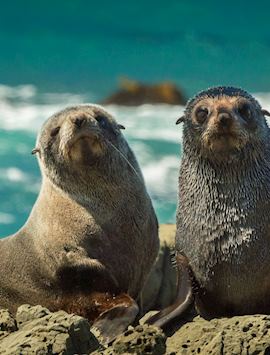New Zealand’s star shows no signs of being on the wane. More visitors than ever are heading to Aotearoa (‘Land of the Long White Cloud’) to experience its natural and cultural marvels, from Milford Sound to M─üori heritage. However, more visitors equals more crowds.
For a more leisurely and intimate vacation in New Zealand, consider the alternatives to the headline activities and destinations. We’ve made a point of seeking out elusive, more private experiences, whether it’s taking on an oft-overlooked walking track, embarking on one-on-one tours with private guides and experts, or simply choosing to focus your time in a region or town that receives far less footfall.
It’s possible to incorporate all the ideas our specialists have suggested below into a three-week trip.
North Island
1. The Coromandel Peninsula
I like to start my clients off in this semi-tropical, forested finger of land only a three-hour drive from Auckland. ItŌĆÖs a place for easing into New Zealand after stepping off the plane, and it has some of the countryŌĆÖs best beaches, including crescents of white sand like CookŌĆÖs Beach (good for swimming) and wide, empty, breeze-buffeted stretches where IŌĆÖve walked early on a morning and not seen a soul.
There are also some excellent, good-value B&Bs here like Hahei, set in flowered gardens and offering the kind of welcoming, warm-hearted hosts that are so typical of New Zealand.
To make the most of your time in the Coromandel, you could warm up your leg muscles (good for all those tramping tracks to come) with a cycle or walk along Karangahake Gorge, a former mining route that culminates in some ŌĆ£staircaseŌĆØ cascades, Owharoa Falls.
For a deeper exploration of the regionŌĆÖs 19th-century mining heritage, you could spend a day with Kiwi Dundee, a local guide and naturalist whoŌĆÖll take you deeper into the rainforested peninsula, through old mining tunnels.
HeŌĆÖll also show you secrets of bush medicine, like which plants have been traditionally used as anaesthetics, and lead you into caves spangled with glow-worms. On his tours youŌĆÖll even have the chance to visit one of the CoromandelŌĆÖs more popular, but nonetheless novel, spots ŌĆö Hot Water Beach, where you can dig out your own little foot spa in the sand.

2. Rotorua
Geysers that erupt on cue, sulphuric pools an outlandish shade of banana-yellow, mud that bubbles and burps, as if some beast of the underworld were dwelling just below the surfaceŌĆ” RotoruaŌĆÖs geothermal theatrics have understandably earned it a high place on travel wish lists.
But, what many visitors donŌĆÖt fully appreciate is that Rotorua and the surrounding region, known as the thermal plateau, is hugely rich in M─üori culture. I can think of no better place to get a sense of this essential aspect of New Zealand than at Te Puia, a M─üori cultural hub-come-geothermal valley.
What I really like about Te Puia is that you wonŌĆÖt just get to marvel at features like billowing geysers and silica terraces. With a guide from the local iwi (tribe), youŌĆÖll explore how the M─üoriŌĆÖs lives were indelibly interwoven with the volatile landscape they inhabited ŌĆö how they used geothermal features to cook and survive, and how these phenomena shaped their mythology and worldview.
Best of all, I think, youŌĆÖll get to visit Te PuiaŌĆÖs arts institute, seeing first hand how M─üori arts like leatherwork, bone-carving, and greenstone carving are being taught and passed on to assiduous M─üori students.
3. Tongariro National Park
Heading south from Rotorua, you enter a region that’s another item on the roll-call of New Zealand’s dizzying topographical variety. Shortly after leaving the great blue calm of Lake Taupo, you’re among lunar-like plains and scrubby, desert-esque terrain on the approach to three volcanic peaks, Tongariro, Ruapehu, and Ngauruhoe. It’s obligatory here to tell you that the latter played Mount Doom in Peter Jackson’s The Lord of the Rings, but its cindery, sheer slopes are suitably foreboding in real life, too.
You can admire the trio on the Tongariro Alpine Crossing, a day hike that truly resembles walking through Mordor. Be prepared for some steep, rocky ascents that, at times, can make you feel like you’re Frodo and Sam scaling the stairs of Cirith Ungol.
The views are wide-reaching, the Martian-like landscapes beguiling, and there’s the bonus of some jewel-bright, turquoise crater lakes and a field of fumaroles toward the end. And, even if you don’t want to follow this route, there are many other shorter, well-marked trails around the park.
You can also join a driving route called the Forgotten World Highway from this region. It’s an almost eerily quiet slice of backcountry that feels, as the name suggests, lost to time.
Traversing mountain saddles, you’ll pass by the skeletons of coal-mining villages and an abandoned flour mill, the remnants of early settlers who eked out a living here. After five hours or so, you can reward your intrepid wanderings with a soak in the lovingly maintained natural mineral pools at Waihi.
4. Wellington
New Zealand’s capital, with its sloping hillsides of higgledy-piggledy houses, can feel a little like a miniature San Francisco (it even has a funicular). But, the main reason to come to Wellington, in my book — other than to catch the ferry to the South Island — is to visit Te Papa Tongarewa, the National Museum of New Zealand. It’s a futuristic-looking conglomeration of stone, steel and multi-hued panels that sits in pride of place on the waterfront.
Spread over its six levels are interactive exhibits celebrating and explaining New Zealand’s history, geology, nature, and both M─üori and P─ükeh─ü (white New Zealander) cultures. You could spend days on exhibits like the earthquake simulator, or the colossal squid suspended eerily in an inky 6 m (20 ft) long tank.
But, if you really want to delve into New Zealand’s secret archives, I recommend taking a backstage tour: around 95% of Te Papa’s collections are not on display, including the most sacred M─üori relics.
Lisa, the M─üori collections manager, took me behind the public galleries into a vast room filled with what looked like row after row of filing cabinets. The air suddenly felt much cooler: “to protect all the wood,” she explained. Then she began pulling items out of cabinets and holding them out for me to examine.
I saw the raggedy Union Jack that flew at the signing of the Treaty of Waitangi in 1840, then several types of kakahu (chiefs’ cloaks) and a taiaha, a chief’s spear with a carved wooden handle. Lisa demonstrated how this weapon would’ve been commonly used in hand-to-hand combat, the ring of feathers around the handle soaking up the blood.

South Island
5. The Marlborough Sounds
IŌĆÖm always amazed how many people rush through these shards of land en route to or from the North and South Islands. These flooded river valleys are perhaps one of New ZealandŌĆÖs greenest areas. Thickly carpeted in native bush that grows all the way down to the waterŌĆÖs edge, this sinuous, splintered coastline conceals sheltered bays and inlets, sometimes petering out into wave-lashed promontories and spits.
It's one of those rare places where the water is so clear, youŌĆÖll be able to see the bottom quivering below you. As a swimmer, I thought this was excitement enough, but one day when I was out exploring, two bottlenose dolphins popped up alongside my kayak. You could also see orca here.
Where you stay is all part of your experience ŌĆö the Sounds make for a restful midpoint in the middle of your trip. You could base yourself at Bay of Many Coves, a chic retreat nestled in an out-of-the-way bay, with eco-friendly wooden buildings that meld into the surrounding bush.
ItŌĆÖs worth lingering longer if you can, perhaps walking part or all of the Queen Charlotte Track. This tramp straddles a ridgeline looking across the gently rippling waterways of both Queen Charlotte and Kenepuru Sounds. Sometimes it dives into ferny bush, and emerges onto sandy beaches or bluffs.

6. Akaroa & Banks Peninsula
Christchurch draws the majority of visitors coming to New Zealand’s east coast, as it’s a termini of the TranzAlpine, one of New Zealand’s most scenic train journeys. But, the volcanic-carved Banks Peninsula, a sleepy, laid-back nub of the country that’s mostly farmland and craggy headlands, makes for a pleasant detour and is only a 90-minute drive away.
I’d make a beeline for Akaroa and Akaroa Harbour, where French settlers attempted to set up a colony in 1840 but were thwarted by the signing of the Treaty of Waitangi. Their influence lives on there in the boulangeries that pepper the streets bearing French names near the waterfront, and the tricolore hanging from buildings. You can easily while away a morning here, ambling around its craft shops and stopping for café au lait.
Akaroa is also a good place to swim with dolphins responsibly — in this case, the rare and diminutive Hector’s dolphin. I actually prefer doing this here than in Kaikoura as it’s so much quieter.
I haven’t routinely recommended places to stay, but there are a couple of properties in this area I’d like to shout about. Firstly, there’s Annandale, a luxury coastal retreat located in a bay that’s so tucked away, you’ll need to be driven to it by private 4x4. It’s ideal for honeymooners or anyone who wants seclusion.
For something more centrally located in Akaroa, there’s the quaint, clapboarded French Bay House, a B&B with leafy, flowered gardens and very helpful hosts.

7. Arrowtown
Wineries: there are many to choose from in New Zealand. The area around the former gold-rush settlement of Arrowtown has some of the best, in my view, and theyŌĆÖre a more boutique alternative to the big-name estates around Blenheim at the top of South Island.
You could even stay in one. Kinross Cottages sits among pinot vines (and acts as the cellar door for five local wineries). They have a welcoming restaurant serving fresh, seasonal dishes and providing copious opportunities to sample the local drop.
If you time your visit for New ZealandŌĆÖs autumn (March to May), the vines themselves turn burnished gold, making for even better vistas.
IŌĆÖd suggest Arrowtown, with its Wild-West-style clapboard shopfronts and 19th-century minersŌĆÖ cottages, as a substitute for the much busier Queenstown, 25 minutes away by car. From the township, you can still explore all the delights of the Otago region and use it as your jumping-off point for getting to Fiordland and Doubtful Sound.

8. Doubtful Sound
Imagine the best bits of Milford Sound without the ever-present hum of scenic aircraft flights and the constant relay of cruise ships. Doubtful Sound, more remote and harder to reach, has the same magisterial scenery without the hordes of visitors.
Think arrow-headed peaks, their every inch covered in thick podocarp rainforest, layers of humus, moss, and totara, rimu and miro trees. The peaks rise vertiginously out of deep cobalt-blue fiords, with white-water cascades pouring down their sides. The occasional pod of bottlenose dolphins weave their way through the waters. The best way to experience it all is by taking an overnight cruise on a very small vessel (some hold only eight people, including the skipper, Jason, and the cook, Kirsten, who doubles up as the dinnertime pianist).
Cabins are modest and you all eat together. The food, however, is really high-end (our meals included venison and an afternoon cheeseboard). Jason will let you clamber up into the wheelhouse, where he’ll show you the depth gauges whose readings change drastically depending on your position in the fiord.
Getting to Doubtful Sound involves crossing Lake Manapouri, a glacially formed body of water overlooked by the Cathedral Mountain range and dotted with 30-odd small islands. Then you travel by 4x4 over the Wilmot Pass, a road hewn through the bush and originally built as an access track for the Manapouri hydro-power station that sits at Deep Cove.
It’s from this road that you first glimpse the fiord, more precisely the glistening Malaspina Reach stretching out amid sheer-sided peaks toward the Tasman Sea. Sometimes, fresh snowfall speckles the peaks.
We boarded our vessel and cruised down the reach. Jason passed around rods and we stopped to fish, hauling up meaty blue cod (later eaten in crispy batter for dinner) and pulling up crayfish pots to reveal monster-sized specimens (needless to say, they also became dinner).
We went on to pass a colony of fur seals on the Shelter Islands, the rocks close to where Doubtful Sound meets the sea. It was here, when we’d stopped to kayak in a small bay, the rain started. But, with waterproofs on, it really didn’t matter.
In fact, when you’re visiting this area of New Zealand, rain brings a particularly important pay-off. Doubtful Sound only has three permanent cascades, the rest depend on heavy rainfall. When I visited, the bare rock walls were awash with columns of water gushing down their sides and splattering the boat with spray. In other parts, the rain had caused landslips, leading to tree avalanches that appeared like scars on the otherwise densely green sides of the peaks.

9. The Catlins
Petrified forest on wave-cut platforms, tracks leading to waterfalls and blowholes, huge caverns only reachable at low tide, beaches populated only by sea lions ŌĆö I love the Catlins. This coastal region deep in the southeast of South Island receives very little footfall from overseas visitors, and thatŌĆÖs precisely why you should go.
ItŌĆÖs the type of place where you can set out on a hike and see nobody for hours. Where you can be driving along and stop to snack on fresh whitebait sold at a roadside hut.
If youŌĆÖre a birdwatcher, I can book you a premium-view seat at Oamaru Blue Penguin Colony, where you can watch New ZealandŌĆÖs rarest and most entrancing penguins come ashore to nestle in their burrows for the night.
For larger bird species, you could walk to Nugget Point, a lighthouse at the end of a headland overlooking a series of pinnacle rocks. On a good day you might sight shearwaters, shags, and penguins from up here, along with seals.

10. Stewart Island
If you have set your heart on seeing kiwis (not to mention other rare native birds) in their natural habitat, and are happy to travel beyond the mainland, think about venturing out to Stewart Island.
This Singapore-sized corner of New Zealand is so far-flung, few visitors ever make it there. Marooned 32 km (20 miles) from the South Island by the stormy Foveaux Strait, it’s an unspoiled, hilly wilderness of mostly predator-free bushland dense with tufty crown ferns. Isolated sandy coves mottle the coastline.
A few hundred M─üori and Europeans have eked out a living on Stewart Island over the years, mostly through fishing and aquaculture. But happily, it’s rare avifauna such as tui, saddlebacks, and wekas, as well as pelagic species like sooty shearwaters, that are really flourishing here. And, just a 20-minute light-aircraft flight from Invercargill, this natural sanctuary isn’t quite as remote as you might think.
To be in with a good chance of seeing a kiwi (there are 22,000 breeding pairs on Stewart Island, where they’re not deemed as endangered), you need to take a guided walk at dusk. Some walks take you through native bush to reach a beach at low tide, when kiwis emerge from the forest or dunes to eat the kelp strewn across the sand. But I saw a jaw-dropping ten tokoeka kiwis on the island’s airstrip in Oban, the island’s one town.
“Why are we here?” I remember thinking, as our guide waved his infra-red torch over the field’s long grasses. But sure enough, there they were, feasting on grubs that emerge at night. I soon grew to love everything about the kiwis we were watching, from their high-pitched, only slightly blood-curdling cries to the way they run (they look as though they’ve got their hands in their pockets).
And to top it off, I remember looking up, as the kiwis snuffled not far from our feet, and seeing the Milky Way resplendent in the sky.
Start planning your trip to New Zealand
Start thinking about your experience. These itineraries are simply suggestions for how you could enjoy some of the same experiences as our specialists. They're just for inspiration, because your trip will be created around your particular tastes.
View All Tours in New Zealand



